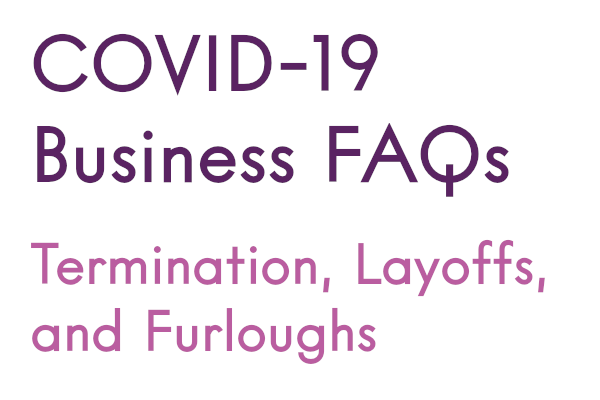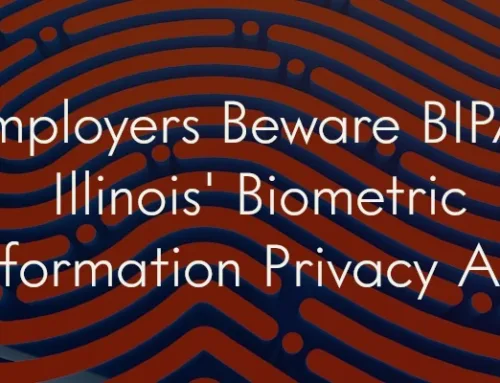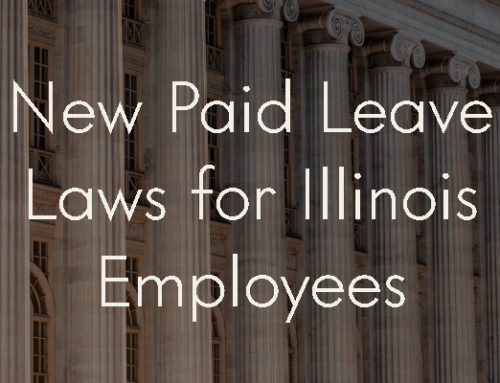Disclaimer: We are not experts in health or policy and make no guarantees as to the accuracy or timeliness of the details on this page. This page is for informational purposes only. See our full COVID-19 disclaimer for more.
If your business has hit trouble because of the pandemic and you need guidance, the attorneys at G & G Law have assembled a toolkit of accessible, easy-to-digest information that answers many common questions we’ve received from our clients. You can read more about it and purchase it here.
Last updated on March 28th, 2020
This article discusses the various employment options business owners are likely considering during this difficult time, primarily terminations, layoffs, and furloughs, and some of the legal implications of each.
- What are the legal issues if I terminate my employees?
- Severance
- The Workplace Transparency Act
- What’s the difference between a layoff and a furlough?
- What are my notice obligations under the WARN Act?
- Does the WARN Act have any exceptions?
What are the legal issues if I terminate my employees?
All employee terminations carry the risk of a legal challenge, even in a pandemic. Much of an employer’s risk depends upon their policies, if the employee had an employment contract in place, and any employment status defined in their contract.
Illinois law generally presumes that employment is “at-will,” unless the employee can prove otherwise, usually through written documents. An “at-will” employer is an employer who reserves the right to terminate employees without cause. This means either the employee or the employer may terminate their work relationship at any time without prior notice or without the need for just cause.
Even though at-will employers generally do not need to worry about a breach of contract claim or a wrongful discharge claim, many other possible claims can be made by employees related to their termination. As a result, it is important for employers to always maintain documentation of employees’ performance and reason(s) for termination. Terminations are always easier to defend if the employer can demonstrate a legitimate business reason. A few examples include: issues with the employee’s contributions, misconduct, a reorganization, or financial considerations of an employer (likely the most relevant reason in our current circumstances).
While the general rules of parting ways with “at-will” employees are very forgiving, there are exceptions. You cannot terminate any employee as a result of discrimination, retaliation for a workplace action, or any reason that violates public policy, such as for using sick leave or for being part of a protected class. Protected classes vary between federal, state, and even city laws.
In all 50 states, federal law makes it illegal to discriminate based on:
- Race;
- Color;
- National origin;
- Religion;
- Sex (including pregnancy, childbirth, and related medical conditions);
- Disability;
- Age (40 and older);
- Citizenship status; and
- Genetic information.
Illinois state law prohibits discrimination based on:
- Race;
- Color;
- National origin;
- Religion;
- Sex (including pregnancy, childbirth, and related medical conditions);
- Disability: physical or mental;
- Age (40 and older);
- Genetic information;
- Marital status;
- Sexual orientation;
- Citizenship status;
- Military and veteran status;
- Unfavorable military discharge;
- Gender identity;
- Arrest record;
- Victims of domestic violence;
- Status as being under an order of protection; and
- Lack of a permanent mailing address or using the mailing address of a shelter or social service provider.
Chicago’s ordinances prohibit discrimination based on:
- Race;
- Sex (including pregnancy & sexual harassment);
- Marital Status;
- Color;
- Age (over 40);
- Parental Status;
- Ancestry;
- Disability;
- Source of Income;
- National Origin;
- Sexual Orientation;
- Military Discharge;
- Status Religion;
- Gender Identity;
- Credit History (employment only);
Severance
Following a termination, if any severance benefits are provided (such as severance pay, payment of medical insurance premiums, or outplacement counseling), an employer should consider making the benefits conditional upon an employee signing a release of claims. For releases to be legal under federal age discrimination laws, they must contain several specific provisions, such as a 21-day consideration period (for employees who are age 40 and over) and a 7-day revocation period. The laws dictating consideration and revocation periods vary state-by-state, so check the law in your state for specifics.
The Workplace Transparency Act
The Workplace Transparency Act, effective at the beginning of 2020, places strict legal requirements on Illinois employers in the use of Severance and Release Agreements. Notably, the Illinois employee must be offered, in writing, 21 days to think over signing the agreement, regardless of the employee’s age. This is a new requirement in Illinois and differs from Federal law, where this period is only required for employees 40 years and older. Illinois employees may sign at any point prior to the end of the 21 days, but only if they also provide a waiver in writing acknowledging they are foregoing the remaining consideration period.
In addition, Illinois employees are now granted a review period to revoke their acceptance of the Separation and Release Agreement, lasting 7 calendar days. This review period can also be waived “knowingly and voluntarily” by the employee. This waiver must also be in writing.
Lastly, employers are now required to notify the employee, in writing, of the employee’s right to have an attorney or representative of their choice review the Separation and Release Agreement before it is executed.
What’s the difference between a layoff and a furlough?
A layoff can be either a temporary or permanent cessation of an employee’s work. Unlike a termination for cause, a layoff means the employee is generally entitled to collect unemployment insurance and benefits. In some situations, temporarily laid-off employees may also be able to keep their benefits coverage (e.g. medical and dental insurance. For permanent layoffs, a severance package usually enters the picture.
A furlough usually involves reducing the days or weeks an employee can work. Typically, furloughed employees are unpaid for a specified amount of time before they are allowed to return to work. Often confused with a layoff, a furlough differs in that the employee will continue to hold and work their job as though their time away were days off without pay, similar to unpaid leave.
There are four key differences between a furlough and a layoff.
- Furloughed employees expect that they will return to work. Typically, an employer will give furloughed employees either a specific date or a specific condition for resuming duties. Employees that are laid off do not always have an expectation that they will be able to return to their previous positions.
- Furloughed employees typically retain their benefits. Most notably, furloughed employees usually retain access to any health and life insurance. Employees who are laid off do not usually retain their employer-sponsored plans; however, there are exceptions.
- Furloughed public employees retain their employment rights. Government employees cannot be fired or replaced without process. For a public employee who has been furloughed rather than laid off, this means that they have a presumptive right to return to that position if they so choose and it still exists.
- A furlough is relatively seamless. Laying off employees requires significant process, as does hiring new staff. This can be time consuming and expensive. By contrast, a furloughed employee can come and go fairly easily.
When employees are furloughed, employers should expect that they will not work, including checking email and voicemail. Employers should therefore inform employees that work is not authorized during the furlough period without written approval in advance.
What are my notice obligations under the WARN Act?
Many employers facing COVID-19 employment decisions worry about whether or not they have an obligation under the federal WARN Act or a similar state “mini-WARN” Act to provide notice before announcing a round of layoffs or furloughs. Note at the outset that such notice is not needed for all layoffs; temporary layoffs (those less than six months) are not considered “employment losses” under either the Federal or Illinois WARN Acts and therefore do not trigger their notice requirements.
- The Illinois WARN Act:
- Illinois WARN applies to employers with 75 or more full-time employees (excluding part-time workers) and requires employers to provide 60 days advance notice of pending plant closures or mass layoffs.
- Mass layoff: A reduction in force at a single site of employment that is not the result of a “plant closing” and results in employment losses during any 30-day period (or, in some cases, during any 90-day period) of 250 or more full-time employees, or 25 or more full-time employees if they constitute one-third or more of full-time employees at the site.
- Employer Damages: These can include back pay, benefits, and civil penalties for each affected employee for each day of defective notice, subject to many technical rules, if an employer fails to provide the required notice.
Given the uncertainty and fluidity of the COVID-19 pandemic, employers looking to be proactive should consider giving advance notice whenever they can, though there will inevitably be instances where this will not be practical or possible.
Does the WARN Act have any exceptions?
The following are potential alternatives to the WARN Act, as well as exceptions written into the federal and state statutes.
- No Layoffs: Many employers may ask their workforce to voluntarily take vacations, accept reductions in pay, work fewer hours, take leave to take care of family members, accept voluntary termination packages, engage in community efforts to slow the pandemic, etc. Such efforts may avoid these employees’ absence count as “employee losses” under the WARN Act. However, they may raise a host of other potential wage and hour issues and should therefore should be discussed with your attorney before you take any action.
- Unforeseeable Business Circumstances: Both the federal and Illinois WARN Acts contain an exception for “unforeseeable business circumstances”
- Illinois: When the closing or mass layoff is caused by business conditions that were not reasonably foreseeable at the time that 60-day notice would have been required (e.g. the unexpected cancellation of a major order), then a business can avoid following the normal notice procedures set out by the WARN Act. Employers should still work to provide as much notice as possible and clearly explain the reason for the shorter notice.
The WARN Act expressly recognizes that “an unanticipated and dramatic major economic downturn might be considered a business circumstance that is not reasonably foreseeable.” It would be hard to argue that COVID-19 has not caused such conditions, given the swift and drastic responses by federal and state governments, as well as the nation’s Federal Reserve Bank. - Natural Disaster Exception: Both the federal and Illinois WARN Acts also include a “natural disaster exception.” The normal 60-day notice requirement is not required for employment losses that are a direct result of “natural disasters” (defined as floods, earthquakes, droughts, storms, tidal waves or tsunamis, and similar “effects of nature”). When relying on this exception, employers are required to give as much notice as is practicable, containing as much of the required information as is available regarding the circumstances of the disaster, whether in advance or after the fact. While the COVID-19 pandemic might qualify as a natural disaster, plaintiffs’ attorneys may make the argument that the employment losses were not directly caused by COVID-19, but rather by the economic constriction following the spread of the pandemic. A more logically sound argument however, seems to be that the deteriorating economic and business conditions are a direct result of the outbreak; look no further than the record 3.28 million initial jobless claims filed across American this week alone.





